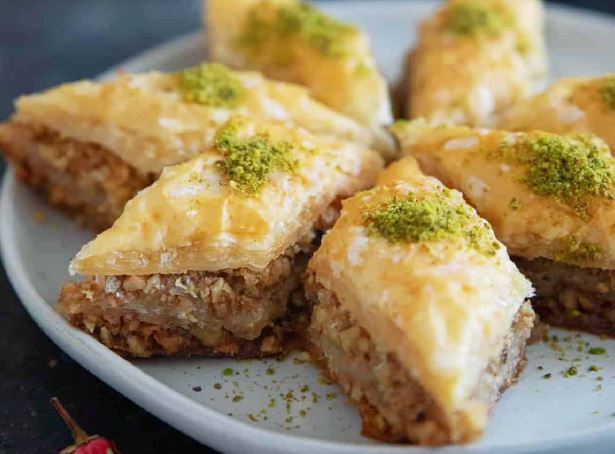Baklava is a delectable and indulgent dessert that has its roots in the ancient Middle East and Mediterranean regions. The history of baklava can be traced back to the Assyrians, who are believed to have been the first to create a similar pastry made from nuts and honey. The dessert then traveled through various cultures, including the Byzantine and Ottoman Empires, before becoming the well-known treat we enjoy today.
The name “baklava” is said to have originated from the Mongolian-Turkic word “bakla,” which means beans, reflecting the early use of legumes in the preparation of similar pastries. Over time, the recipe evolved, and nuts, particularly pistachios and walnuts, became the primary filling.
Baklava spread across the Mediterranean, North Africa, and the Middle East through trade and cultural exchanges, each region adding its own unique twist to the dessert. Today, baklava is a beloved treat enjoyed in various forms and flavors across the world.
Our baklava recipe is a delightful fusion of flavors and textures that pays homage to the rich history of this ancient dessert. The layers of flaky phyllo dough filled with a creamy cheesecake mixture and a honeyed walnut filling create a mouthwatering and unforgettable dessert experience.
The story of baklava begins with the preparation of the filling. Cream cheese, sugar, flour, eggs, sour cream, honey, and ground cinnamon are expertly combined to create a smooth and luscious cheesecake mixture. In a separate bowl, finely chopped walnuts are tossed with more honey and ground cinnamon, creating a delectable walnut filling.
To assemble the baklava, a 9-inch springform pan is greased and lined with phyllo dough, adding melted butter between the layers to ensure they stick together. A small amount of cheesecake filling is added to the pan, followed by an even layer of the walnut filling. The remaining cheesecake filling is then spread on top to complete the layers.
The assembled baklava is placed in a larger pan filled with warm water, creating a water bath that helps the dessert cook evenly and retain moisture. The baklava is then baked to perfection, and after cooling, it is topped with a mixture of more walnuts, cinnamon, melted butter, and honey.
The result is a delightful symphony of flavors and textures. The flaky and buttery phyllo dough layers complement the creamy and tangy cheesecake filling, while the honeyed walnut mixture adds a delightful crunch and sweetness. Each bite of baklava is a heavenly experience that transports you to the ancient lands where this exquisite dessert was born.
INGREDIENTS
Crust:
- 4 tbsp butter, melted
- Phyllo dough
Filling:
- 2 (8-ounce) packages of cream cheese, softened
- 2/3 cup sugar
- 2 tbsp all-purpose flour
- 3 eggs
- 2/3 cup sour cream
- 6 tbsp honey
- 1 1/2 tsp ground cinnamon
Topping:
- 3 3/4 cups finely chopped walnuts
- 3 tsp cinnamon
- 6 tbsp butter, melted
- 4 tbsp honey
INSTRUCTIONS
- Preheat the oven to 300 degrees Fahrenheit (150 degrees Celsius).
- In a large bowl, mix the cream cheese, sugar, and flour until combined. Scrape down the sides of the bowl.
- Add eggs one at a time, beating slowly and scraping the sides of the bowl after each addition.
- Add the sour cream, honey, and cinnamon. Beat on low speed until well combined. Set aside.
- In a medium-sized bowl, toss together 2 1/2 cups of chopped walnuts, 2 tsp ground cinnamon, 4 tbsp melted butter, and 6 tbsp of honey. Set aside.
- Grease a 9-inch springform pan and cover the outside with aluminum foil.
Crust:
- Unroll the phyllo dough according to package instructions. Keep it from drying out by placing a damp towel over the pieces that haven’t been used yet.
- Using one piece at a time, place phyllo sheets into the bottom and up the sides of the springform pan. Layer the melted butter between the phyllo sheets so that they stick together.
- Once the crust is ready, add a small amount of cheesecake filling to the pan.
- Add the walnut filling in an even layer on top of the cheesecake filling.
- Add the remaining cheesecake filling and spread it into an even layer.
- Place the springform pan (covered with aluminum foil) inside another pan. Fill the outside pan with enough warm water to go about halfway up the sides of the springform pan. The water should not go above the top edge of the aluminum foil on the springform pan.
- Bake for 50-60 minutes.
- Turn off the heat and leave the cheesecake in the oven with the door closed for 30 minutes.
- Crack the oven door and leave the cheesecake in the oven for about 20 minutes.
- Remove the cheesecake from the oven and chill until completely cool and firm.
- To finish off the baklava, toss together the remaining 1 1/4 cups walnuts, 1 tsp cinnamon, 2 tbsp melted butter, and 4 tbsp honey. Top the cheesecake with whipped cream and the walnut mixture.
Indulge in the rich and aromatic flavors of baklava, a dessert that carries the legacy of ancient traditions and delights the taste buds with its decadent combination of creamy cheesecake, honeyed walnuts, and flaky phyllo dough. Each slice is a celebration of history and culinary artistry, making baklava a true treat for all dessert enthusiasts!





